Interdependence in Coastal Tourist Territories between Marine Litter and Immediate Tourist Zoning Density: Methodological Approach for Urban Sustainable Development
Abstract
:Highlights
- The presence of marine litter in sublittoral areas is determined by the density of coastal tourist territories and is lower in areas predominantly used for tourism versus those of mostly resi-dential use;
- Data collection methodology using depth line transects is essential for estimating marine litter density;
- The presence of macro debris from motor vehicle tyres is independent of urban areas and their associated density and is also unrelated to maritime access.
- The density of coastal tourist territories plays a crucial role in determining the possible presence of marine litter in sublittoral areas and developing specific preventive policies;
- It is not possible, with current technology, to use remote means of complex surface and bottom collection of marine litter without depth transects;
- The deposition of a characteristic type of marine litter, used tyres, shows patterns of occurrence totally independent of coastal urban density.
Abstract
1. Introduction
- Lack of waste management infrastructure: due to the population fluctuation between the summer season and the rest of the year, the infrastructure for proper waste management may be inadequately sized. If the collection and treatment network is demarcated based on the permanent residents in these CTTs, garbage containers, recycling facilities, and waste collection systems will not be efficient in managing the large amount of waste generated during the summer season due to the tourist influx;
- Human behaviour: raising awareness among the population, for both permanent residents and tourists, is essential to prevent the generation of marine litter. Environmental awareness and proper waste management on beaches and coastal areas significantly contributes to avoiding the cycle of garbage deposition on the seabed. Similarly, the lack of collection facilities may encourage improper practices such as littering or leaving domestic waste outside established garbage containers;
- Marine activities: blue economy-related activities, such as fishing—both professional and recreational—and navigation, can contribute to the introduction of waste into the sea, either through accidents or improper waste management during these activities;
- Sewer system overflow and climate change: sewer and wastewater treatment systems are positioned based on population needs but may not be designed to handle large volumes of rainwater from heavy storms after an extended period of summer drought, not to mention wastewater exceeding capacity due to a sudden overpopulation. This overflow can result in untreated wastewater discharges directly into the sea, becoming a vector for the entry of pollutants and waste.
2. Framework and Objectives
- (A)
- Urban density and morphology: the definition and measurement of urban density, quantifying parameters related to buildings and population. Includes population, land occupation, typologies, morpho-classification, infrastructure, and urban planning;
- (B)
- Density of marine litter: the definition of elements, origin, material composition, distance to the coast, accumulation, coastal access, and waste management practices;
- (C)
- Multifaceted factors: consumer culture and resident behaviour, especially regarding waste management habits, vary between urban areas and can influence the quantity of waste ending up in the sea;
- (D)
- Transport routes: waste generated in urban areas can reach the marine environment through various transport routes such as rivers, sewer systems, windstorms, and other mechanisms.
- –
- Update the distribution of marine litter in relation to urban and territorial models associated with tourism, highlighting specific models for prevention and decontamination efforts [42];
- –
- Investigate the presence of litter to provide key information for establishing specific waste management needs and awareness policies in the analysed coastal areas [43];
- –
- Possessing precise and updated data on the presence of marine litter in peri-urban environments can enhance the effectiveness of integrated preventive management systems [44].
3. Materials and Methods
3.1. Study Area
3.1.1. Zone 1: Natural Areas (Represented in the Cardoon Ravine)
3.1.2. Zone 2: Self-Built Housing Areas in Assimilated Out-of-Order Nuclei (Substandard Housing)
3.1.3. Zone 3: Residential Areas of Historical Implantation, Immediately by the Sea (Caletillas)
3.1.4. Zone 4: Planned Residential Areas, High Density (Puerto de la Galera)
3.1.5. Zone 5: Planned Low-Density Tourist Areas (Puerto Playa de la Candelaria)
3.2. Data Collection and Modelling
3.2.1. Urban Density Parameterization
3.2.2. Parameterization of Marine Litter
4. Results and Discussion
- [A] = building density (m2/Ha);
- [B] = livings density (viv/Ha);
- [C] = inhabitants density (hab/km2);
- [D] = Medium depth (m);
- [E] = overall Surface (Ha);
- [F] = Compactness of the substrate (0.5→2);
- [G] = Plot uses (1→5);
- [H] = building typology (1→5).
5. Conclusions
- The combined data collection methodology, at the urban level using open urban data with QGIS, and marine waste data through dives with in situ reporting, is the only technically feasible method for the combination of density and marine waste in the infralittoral seabed, and cannot be replaced by exclusively massive capture technologies;
- There is a direct relationship between built density and per capita density and the presence of macro waste in the infralittoral seabed. However, residential areas are more contaminated than tourist areas. Nontourist beaches near urban areas without periodic cleaning show higher levels of marine waste, indicating dependence on initial parameters. Nevertheless, even natural areas with less urban pressure also have waste, especially tyres, which is independent of zones and urban densities, and is not related to maritime access;
- This study highlights the limited impact of urban typologies and the predominant use of urban areas on the presence of waste in the associated infralittoral seabed. Therefore, the appearance of marine waste in the infralittoral seabed of the CTTs is more affected by their relational vector in relation to building and urban density than by their coastal morphological qualities;
- No significant differences were observed between sampling depths; however, a higher number of waste items were observed in areas with larger sediment granulometry (zones 3, 4, and 5);
- The waste reappearance effect is the most concerning, and according to the investigated causal relationship, it is directly proportional to the densities of the CTTs. It can be eliminated in natural areas through proper cleaning and waste management. Corrective measures can only act at the source of waste for real and lasting effectiveness, and personalized actions are necessary based on the area.
Author Contributions
Funding
Data Availability Statement
Acknowledgments
Conflicts of Interest
References
- Tsaligopoulos, A.; Kyvelou Stella, S.; Karapostoli, A.; Bobolos, N.; Tsintzou, T.; Lekkas Demetris, F.; Matsinos Yiannis, G. Sound complexity as a strategy for livable and sustainable cities: The case of an urban waterfront. Noise Mapp. 2023, 10, 20220173. [Google Scholar] [CrossRef]
- Correia, A.; Oliveira, C.; Pereira, R. From Emotions to Place Attachment. In Co-Creation and Well-Being in Tourism; Correia, A., Kozak, M., Gnoth, J., Fyall, A., Eds.; Springer International Publishing: Cham, Switzerland, 2017; pp. 163–177. [Google Scholar] [CrossRef]
- Katsanevakis, S.; Katsarou, A. Influences on the distribution of marine debris on the seafloor of shallow coastal areas. Water Air Soil Pollut. 2004, 159, 325–337. [Google Scholar] [CrossRef]
- Díaz Ameneiro, P. Turismo y ordenación del litoral. Análisis comparativo de las propuestas de ordenación de la costa española en relación con el turismo. Cuad. Geogr. 2021, 106, 9–30. [Google Scholar]
- Víctor Pérez, E. La arquitectura española del segundo franquismo y el «Boletín de la dirección general de arquitectura» (1946–1957). RA Rev. Arquit. 2014, 16, 25–40. [Google Scholar]
- Monge Juárez, M. De los Orígenes de un Urbanismo Para el Ocio a la Invención del Verano: Aproximación a un Análisis de los Tiempos de Ocio Durante el Proceso de Industrialización en Elche, 1884–1906. Cuad. Tur. 2021, 47, 263–276. [Google Scholar] [CrossRef]
- Loren-Méndez, M.; Pinzón-Ayala, D. (Eds.) En Ruta Litoral Destino: N-340 (1-1); RU Books: Málaga, Spain, 2017. [Google Scholar]
- Alía Miranda, F. La Dictadura de Primo de Rivera (1923–1930): Paradojas y Contradicciones del Nuevo Régimen; Los libros de la Catarata: Madrid, Spain, 2023. [Google Scholar]
- Tatyana Dimitrova, S.D. Political Leadership and Preservation of National Priorities (on the example of General Primo de Rivera). Hist. Pogl. 2023, 6, 93–112. [Google Scholar] [CrossRef]
- Sainz Gutiérrez, V. Nuevos Enfoques del Urbanismo en Andalucía Durante la Transición: Un Itinerario Para su Estudio. Hist. Actual Online 2023, 61, 173–187. [Google Scholar]
- Kosok, L. Pleasurescapes on the Edge: Performing Modernity on Urban Waterfronts (1880–1960). J. Urban Hist. 2022, 48, 1199–1210. [Google Scholar] [CrossRef]
- Trapero Ballestero, J.J. El proyecto del espacio público y los paseos marítimos. Cuad. Investig. Urbanística 1997, 20, 57–61. [Google Scholar]
- Andrés, M.D.; Barragán Muñoz, J.M. Desarrollo urbano en el litoral a escala mundial. Método de estudio para su cuantificación. Rev. Estud. Andal. 2016, 33, 64–83. [Google Scholar]
- Volz, K. Purpose Built: Architecture for a Better Tomorrow. Archit. Aust. 2023, 112, 18–19. [Google Scholar]
- Asensio-Montesinos, F.; Anfuso, G.; Aguilar-Torrelo, M.T.; Oliva Ramírez, M. Abundance and Temporal Distribution of Beach Litter on the Coast of Ceuta (North Africa, Gibraltar Strait). Water 2021, 13, 2739. [Google Scholar] [CrossRef]
- João Pedro, C.; Maria, J.A.; Francesca Dal, C. The (Re)Industrialised Waterfront as a «Fluid Territory»: The Case of Lisbon and the Tagus Estuary. Urban Plan. 2023, 8, 363–375. [Google Scholar]
- Villanova Solano, C.; Romero Peral, F.; Fernández Martín, S.; Muñoz Molina, M.; Álvaro Berlanga, S. Estudio de la abundancia de microplásticos en doce playas de la isla de Tenerife (Islas Canarias). Sci. Insularum. Rev. Cienc. Nat. Islas 2018, 1, 103–121. [Google Scholar] [CrossRef]
- Baztan, J.; Carrasco, A.; Chouinard, O.; Cleaud, M.; Gabaldon, J.E.; Huck, T.; Jaffrès, L.; Jorgensen, B.; Miguelez, A.; Paillard, C.; et al. Protected areas in the Atlantic facing the hazards of micro-plastic pollution: First diagnosis of three islands in the Canary Current. Mar. Pollut. Bull. 2014, 80, 302–311. [Google Scholar] [CrossRef]
- Fleet, D.; Vlachogianni, T.; Hanke, G. A Joint List of Litter Categories for Marine Macrolitter Monitoring; EUR 30348 EN; Publications Office of the European Union: Luxemburg, 2021; Available online: https://publications.jrc.ec.europa.eu/repository/handle/JRC121708 (accessed on 12 November 2023).
- Ananian, P.; Ebacher, V.; Perras, A. Reconnecting waterfronts and central neighbourhoods: The lessons to be learned from user behaviour for the redesign of public spaces. J. Urban Des. 2022, 27, 110–129. [Google Scholar] [CrossRef]
- Botero, C.M.; Tamayo, D.; Zielinski, S.; Anfuso, G. Qualitative and Quantitative Beach Cleanliness Assessment to Support Marine Litter Management in Tropical Destinations. Water 2021, 13, 3455. [Google Scholar] [CrossRef]
- Chiba, S.; Saito, H.; Fletcher, R.; Yogi, T.; Kayo, M.; Miyagi, S.; Ogido, M.; Fujikura, K. Human footprint in the abyss: 30 year records of deep-sea plastic litter. Mar. Policy 2018, 96, 204–212. [Google Scholar] [CrossRef]
- Zorzo, P.; López-Samaniego Palomino, E.; Miranda, F.J. Problemática de las basuras marinas en España: El proyecto MARNOBA y la experiencia en la Demarcación marina del Estrecho y Alborán. Chron. Nat. 2014, 4, 66–74. [Google Scholar]
- Vélez-Mendoza, A. Marine litter in mangroves: Composition, magnitude, and impacts. Boletín Cienc. Tierra 2022, 51, 50–60. [Google Scholar] [CrossRef]
- Krelling, A.P.; Turra, A. Influence of oceanographic and meteorological events on the quantity and quality of marine litter along an estuarine gradient. Mar. Pollut. Bull. 2019, 139, 282–298. [Google Scholar] [CrossRef]
- Murphy, E.L.; Bernard, M.; Iacona, G.; Borrelle, S.B.; Barnes, M.; McGivern, A.; Emmanuel, J.; Gerber, L.R. A decision framework for estimating the cost of marine plastic pollution interventions. Conserv. Biol. 2022, 36, e13827. [Google Scholar] [CrossRef]
- Topouzelis, K.; Papageorgiou, D.; Karagaitanakis, A.; Papakonstantinou, A.; Arias Ballesteros, M. Remote Sensing of Sea Surface Artificial Floating Plastic Targets with Sentinel-2 and Unmanned Aerial Systems (Plastic Litter Project 2019). Remote Sens. 2020, 12, 2013. [Google Scholar] [CrossRef]
- Ryan, P.G.; Moore, C.J.; Van Franeker, J.A.; Moloney, C.L. Monitoring the abundance of plastic litter in the marine environment. Philos. Trans. R. Soc. B Biol. Sci. 2009, 364, 1999–2012. [Google Scholar] [CrossRef]
- Grelaud, M.; Ziveri, P. The generation of marine litter in Mediterranean island beaches as an effect of tourism and its mitigation. Sci. Rep. 2020, 10, 20326. [Google Scholar] [CrossRef]
- Ruiz Palacios, M.A.; Pereira Texeira De Oliveira, C.; Serrano González, J.; Saénz Flores, S. Analysis of Tourist Systems Predictive Models Applied to Growing Sun and Beach Tourist Destination. Sustainability 2021, 13, 785. [Google Scholar] [CrossRef]
- Lee, J.; Hong, S.; Song, Y.K.; Hong, S.H.; Jang, Y.C.; Jang, M.; Heo, N.W.; Han, G.M.; Lee, M.J.; Kang, D.; et al. Relationships among the abundances of plastic litter in different size classes on beaches in South Korea. Mar. Pollut. Bull. 2013, 77, 349–354. [Google Scholar] [CrossRef]
- Blasco Hedo, E. Real Decreto 1056/2022, de 27 de diciembre, por el que se aprueba el Plan Director de la Red de Áreas Marinas Protegidas de España y los criterios mínimos comunes de gestión coordinada y coherente de la Red. Actual. Jurídica Ambient. 2023, 130, 164–166. [Google Scholar]
- Abramic, A.; García, A.; Fernández-Palacios, Y.; Haroun, R. Bases para la PLAnificación Sostenible de áreas MARinas en la Macaronesia: Proyecto PLASMAR. Okeanos 2020, 11, 8–17. [Google Scholar]
- Day, J.C.; Laffoley, D.; Zischka, K. Gestión de áreas marinas protegidas. In Gobernanza y Gestión de Áreas Protegidas, 1st ed.; Worboys, G.L., Lockwood, M., Kothari, A., Feary, S., Pulsford, I., Eds.; ANU Press: Canberra, Australia, 2019. [Google Scholar] [CrossRef]
- Ivar Do Sul, J.A.; Costa, M.F. Marine litter review for Latin America and the Wider Caribbean Region: From the 1970s until now, and where do we go from here? Mar. Pollut. Bull. 2007, 54, 1087–1104. [Google Scholar] [CrossRef] [PubMed]
- Papageorgiou, D.; Topouzelis, K.; Suaria, G.; Aliani, S.; Corradi, P. Sentinel-2 Detection of Floating Marine Litter Targets with Partial Spectral Unmixing and Spectral Comparison with Other Floating Materials (Plastic Litter Project 2021). Remote Sens. 2022, 14, 5997. [Google Scholar] [CrossRef]
- Compagnone, F.; Varricchione, M.; Innangi, M.; Di Febbraro, M.; Loy, A.; Stanisci, A.; De Francesco, M.C.; Matteucci, G.; Carranza, M.L. Coastal Biodiversity Assessment Aided by Citizen Science Volunteers: A Look at the Italian Central Adriatic. Land 2023, 12, 2023. [Google Scholar] [CrossRef]
- Merlino, S.; Paterni, M.; Locritani, M.; Andriolo, U.; Gonçalves, G.; Massetti, L. Citizen Science for Marine Litter Detection and Classification on Unmanned Aerial Vehicle Images. Water 2021, 13, 3349. [Google Scholar] [CrossRef]
- Nuelle, M.-T.; Dekiff, J.H.; Remy, D.; Fries, E. A new analytical approach for monitoring microplastics in marine sediments. Environ. Pollut. 2014, 184, 161–169. [Google Scholar] [CrossRef] [PubMed]
- Villar Lama, A. El urbanismo en el litoral andaluz tras la última burbuja inmobiliaria: Cambio de ciclo o reincidencia. Boletín Asoc. Geógr. Españoles 2020, 85, 1–4. [Google Scholar]
- Painting, S.J.; Collingridge, K.A.; Durand, D.; Grémare, A.; Créach, V.; Arvanitidis, C.; Bernard, G. Marine monitoring in Europe: Is it adequate to address environmental threats and pressures? Ocean Sci. 2020, 16, 235–252. [Google Scholar] [CrossRef]
- Botello, L.C.S. Impacto Ambiental del Turismo de Buceo en Arrecifes de Coral. Cuad. Tur. 2009, 24, 207–227. [Google Scholar]
- Bellou, N.; Gambardella, C.; Karantzalos, K.; Monteiro, J.G.; Canning-Clode, J.; Kemna, S.; Arrieta-Giron, C.A.; Lemmen, C. Global assessment of innovative solutions to tackle marine litter. Nat. Sustain. 2021, 4, 516–524. [Google Scholar] [CrossRef]
- Suaria, G.; Achtypi, A.; Perold, V.; Lee, J.R.; Pierucci, A.; Bornman, T.G.; Aliani, S.; Ryan, P.G. Microfibers in oceanic surface waters: A global characterization. Sci. Adv. 2020, 6, eaay8493. [Google Scholar] [CrossRef]
- López Arquillo, J.D. Beyond the mirror: Social space, attached space and bathymetry for a sustainable planning in Coastal Tourist Territories (CTT’s). Towards a characterization of the attraction potential. REIA Rev. Eur. Investig. Arquit. 2022, 22, 99–116. [Google Scholar]
- Toribio, M. La Directiva Hábitats 92/43/CE y la Red Natura 2000. Cuad. Geogr. 1999, 29, 143–155. [Google Scholar]
- Serra-Gonçalves, C.; Lavers, J.L.; Bond, A.L. Global Review of Beach Litter Monitoring and Future Recommendations. Environ. Sci. Technol. 2019, 53, 12158–12167. [Google Scholar] [CrossRef]
- Reinold, S.; Herrera, A.; Hernández-González, C.; Gómez, M. Plastic pollution on eight beaches of Tenerife (Canary Islands, Spain): An annual study. Mar. Pollut. Bull. 2020, 151, 110847. [Google Scholar] [CrossRef] [PubMed]
- González-Hernández, M.; Hernández-Sánchez, C.; González-Sálamo, J.; López-Darias, J.; Hernández-Borges, J. Monitoring of meso and microplastic litter in Playa Grande beach (Tenerife, Canary Islands, Spain) during a moon cycle. Mar. Pollut. Bull. 2020, 150, 110757. [Google Scholar] [CrossRef] [PubMed]
- Kroon, F.J.; Motti, C.E.; Jensen, L.H.; Berry, K.L.E. Classification of marine microlitter: A review and case study on fish from the Great Barrier Reef, Australia. Sci. Rep. 2018, 8, 16422. [Google Scholar] [CrossRef] [PubMed]
- Corrigan, B.C.; Tay, Z.Y.; Konovessis, D. Real-Time Instance Segmentation for Detection of Underwater Litter as a Plastic Source. J. Mar. Sci. Eng. 2023, 11, 1532. [Google Scholar] [CrossRef]
- Martín-Rodríguez, F.; Rodríguez-Barreiro, L.; Fernández-Bastos, M.; Iglesias, G.M. LitterDrone: Monitorización de basura marina empleando drones y análisis de imagen. In Proceedings of the URSI-2019, Granada, Spain, 9–13 September 2019. [Google Scholar]
- Escrivá, A.; Armengol, J.; Monrós, J.S.; Rueda, J.; Vera, P.; Barba, E. Caracterización de la Vegetación Subacuática y Palustre del Ullal de Massalavés (Valencia). Flora Montiberica 2008, 39, 50–57. [Google Scholar]
- Solano Martos, J.F. Modelización Para el Estudio, Análisis y Prevención de Riesgos Intrínsecos en Sectores Singulares. Available online: https://search.ebscohost.com/login.aspx?direct=true&AuthType=sso&db=edstdx&AN=edstdx.10803.131412&lang=es&site=eds-live&scope=site&authtype=sso&custid=s1136447 (accessed on 20 October 2023).
- Orlando Herrera, B. Estudio de los Organismos Marinos y Factores de Riesgo a las Faenas Subacuaticas Navales y Deportivas. Boletín Científico CIOH 1993, 14, 91–108. Available online: https://search.ebscohost.com/login.aspx?direct=true&AuthType=sso&db=edsdoj&AN=edsdoj.5b0a9619e147379124228d2749e5fa&lang=es&site=eds-live&scope=site&authtype=sso&custid=s1136447 (accessed on 27 October 2023). [CrossRef]
- Palombi, L.; Raimondi, V. Experimental Tests for Fluorescence LIDAR Remote Sensing of Submerged Plastic Marine Litter. Remote Sens. 2022, 14, 5914. [Google Scholar] [CrossRef]
- Reineccius, J.; Appelt, J.-S.; Hinrichs, T.; Kaiser, D.; Stern, J.; Prien, R.D.; Waniek, J.J. Abundance and characteristics of microfibers detected in sediment trap material from the deep subtropical North Atlantic Ocean. Sci. Total Environ. 2020, 738, 140354. [Google Scholar] [CrossRef]
- Addamo, A.M.; Hanke, G.; Laroche, P. Top Marine Beach Litter Items in Europe: A Review and Synthesis Based on Beach Litter Data; Publications Office of the European Union: Luxembourg, 2017. [Google Scholar]
- Del Río-Rama, M.; Álvarez-García, J.; Oliveira, C. Environmental Practices. Motivations and Their Influence on the Level of Implementation. Sustainability 2018, 10, 713. [Google Scholar] [CrossRef]
- Fetisov, S.; Chubarenko, I. Marine Litter Stormy Wash-Outs: Developing the Neural Network to Predict Them. Pollutants 2021, 1, 156–168. [Google Scholar] [CrossRef]
- Trouwborst, A.; Dotinga, H.M. Comparing European Instruments for Marine Conservation. Eur. Energy Environ. Law Rev. 2011, 20, 129–149. [Google Scholar] [CrossRef]
- Merlino, S.; Locritani, M.; Guarnieri, A.; Delrosso, D.; Bianucci, M.; Paterni, M. Marine Litter Tracking System: A Case Study with Open-Source Technology and a Citizen Science-Based Approach. Sensors 2023, 23, 935. [Google Scholar] [CrossRef]
- Lindgren, A.; Palmlund, J.; Wate, I.; Gössling, S. Environmental management and education: The case of PADI. In New Frontiers in Marine Tourism; Routledge: London, UK, 2007; pp. 115–136. [Google Scholar]
- Weng, K.C.; Friedlander, A.M.; Gajdzik, L.; Goodell, W.; Sparks, R.T. Decreased tourism during the COVID-19 pandemic positively affects reef fish in a high use marine protected area. PLoS ONE 2023, 18, e0283683. [Google Scholar] [CrossRef]
- Kuempel, C.D.; Jones, K.R.; Watson, J.E.M.; Possingham, H.P. Quantifying biases in marine-protected-area placement relative to abatable threats. Conserv. Biol. 2019, 33, 1350–1359. [Google Scholar] [CrossRef]
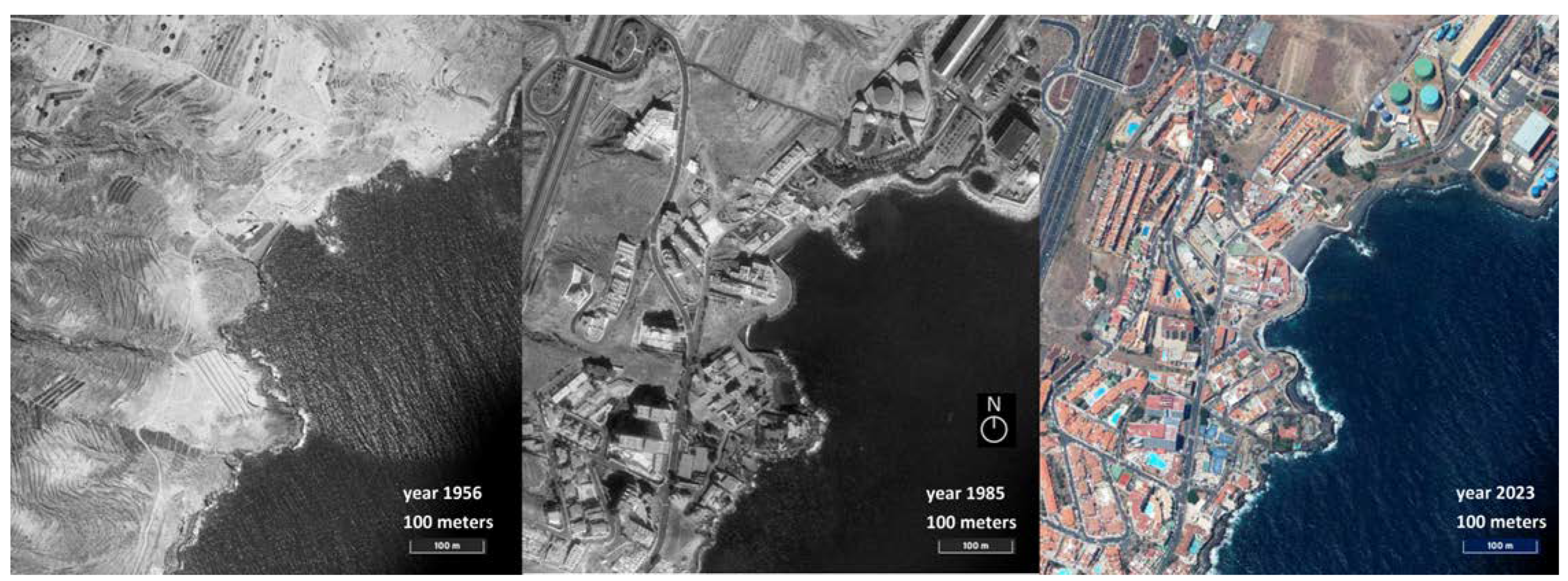
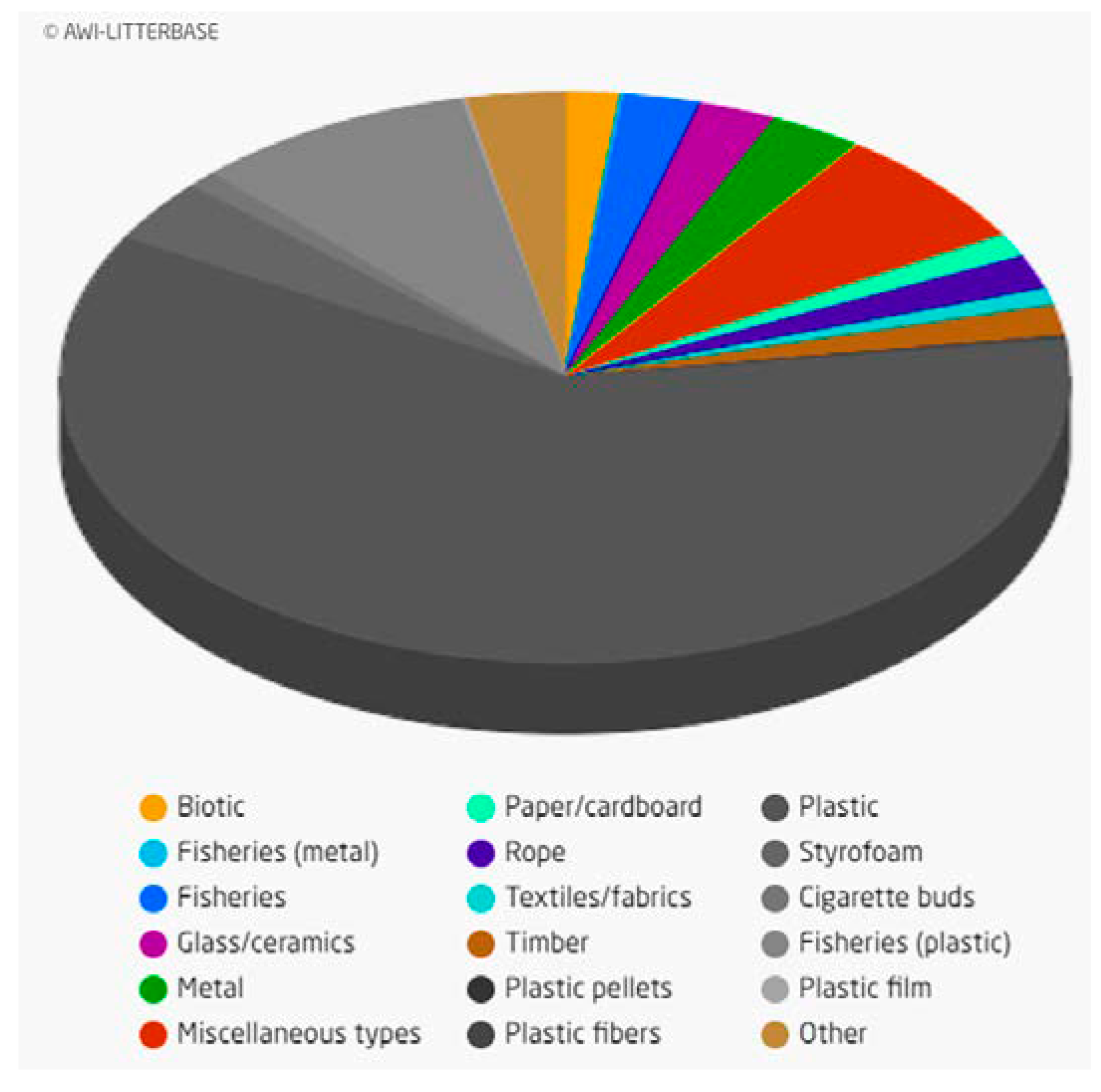
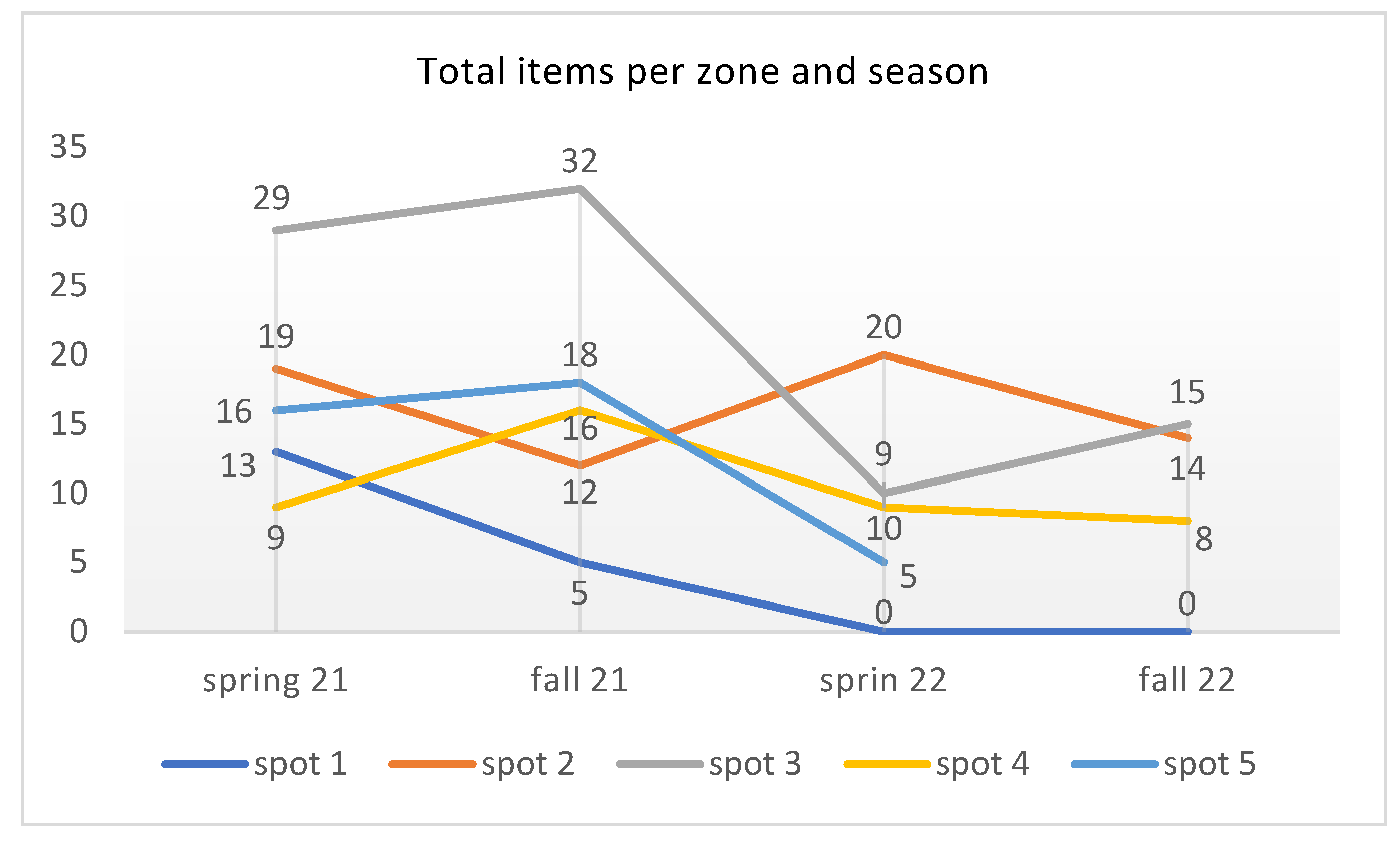
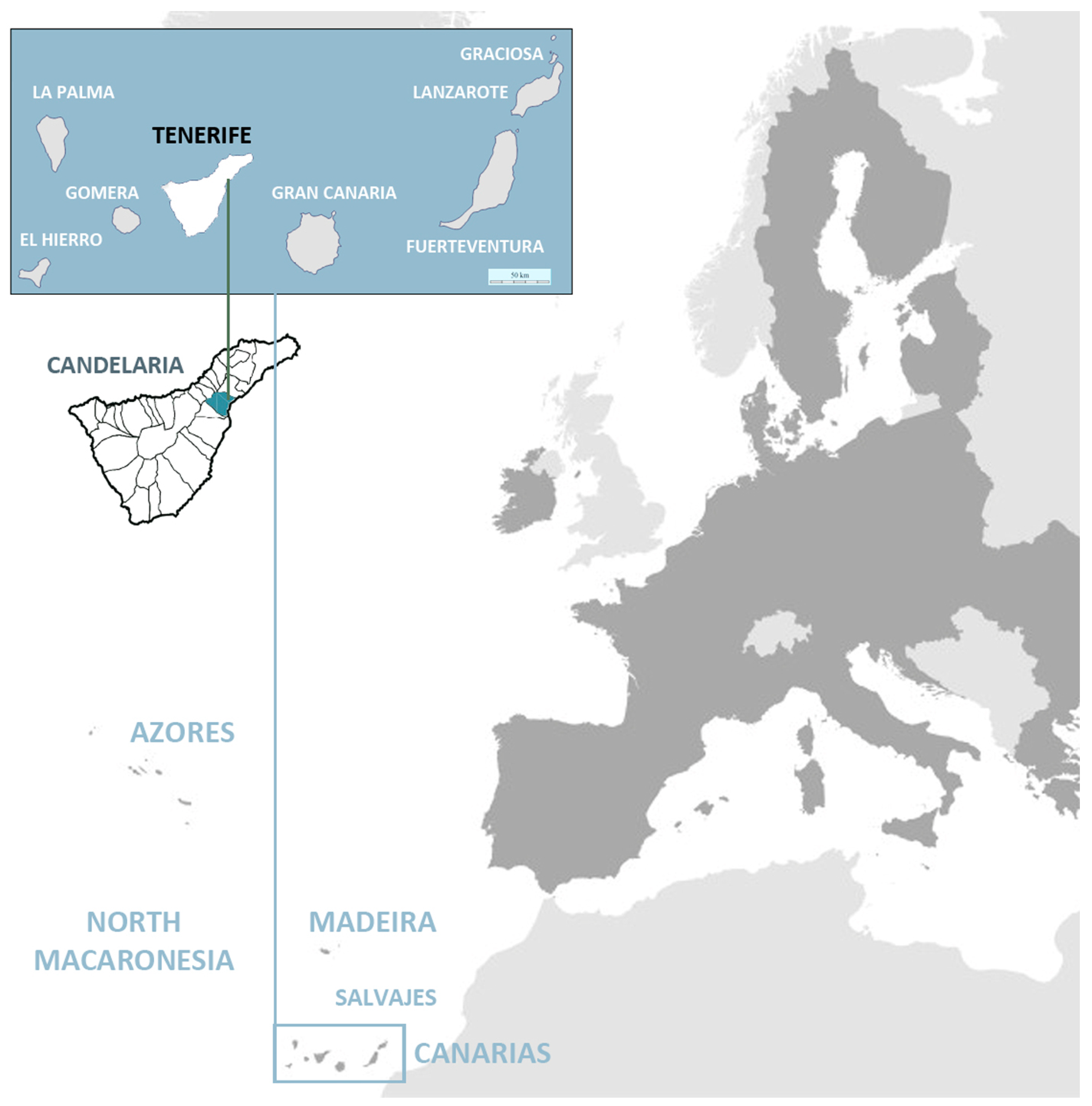

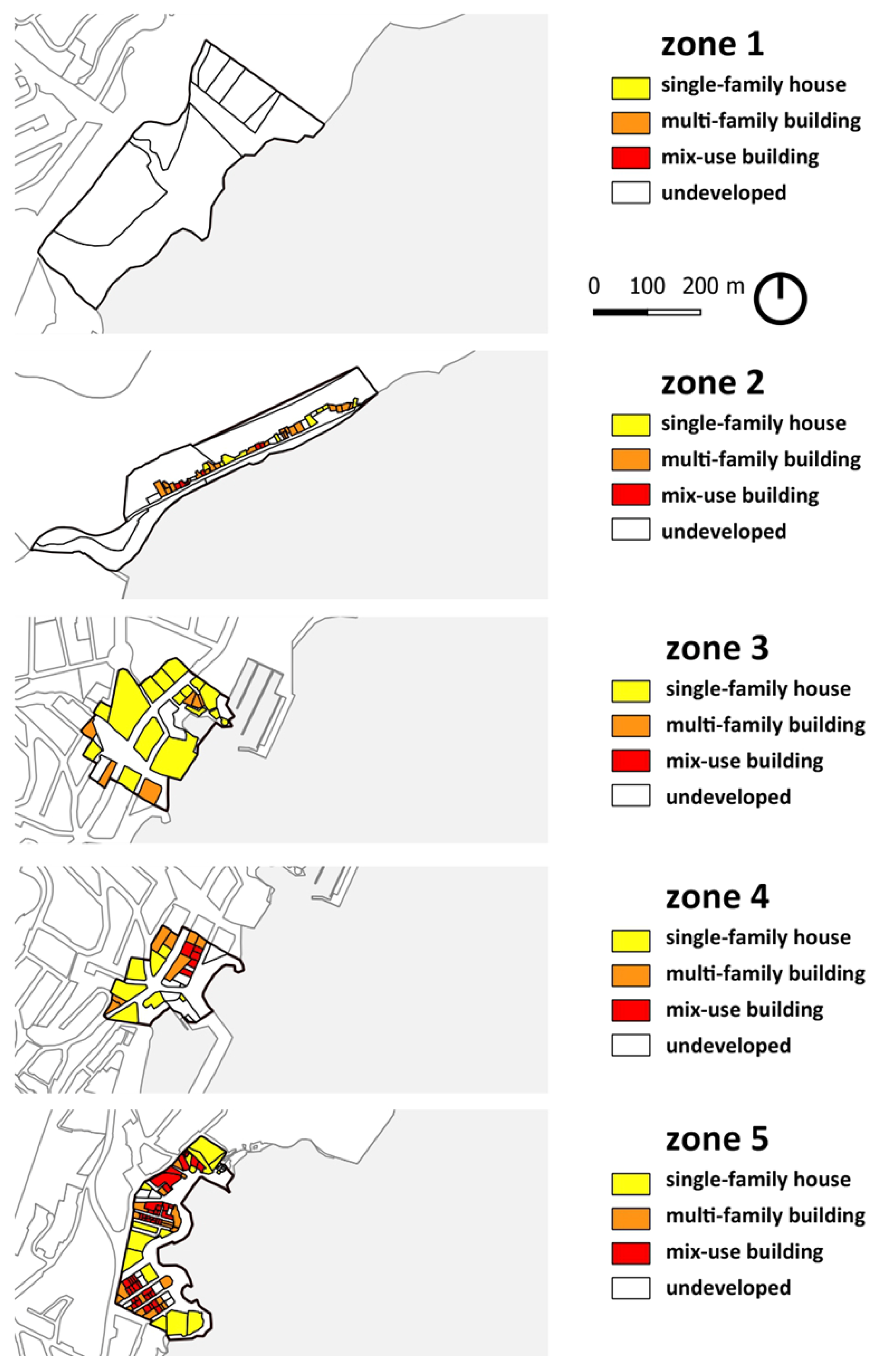

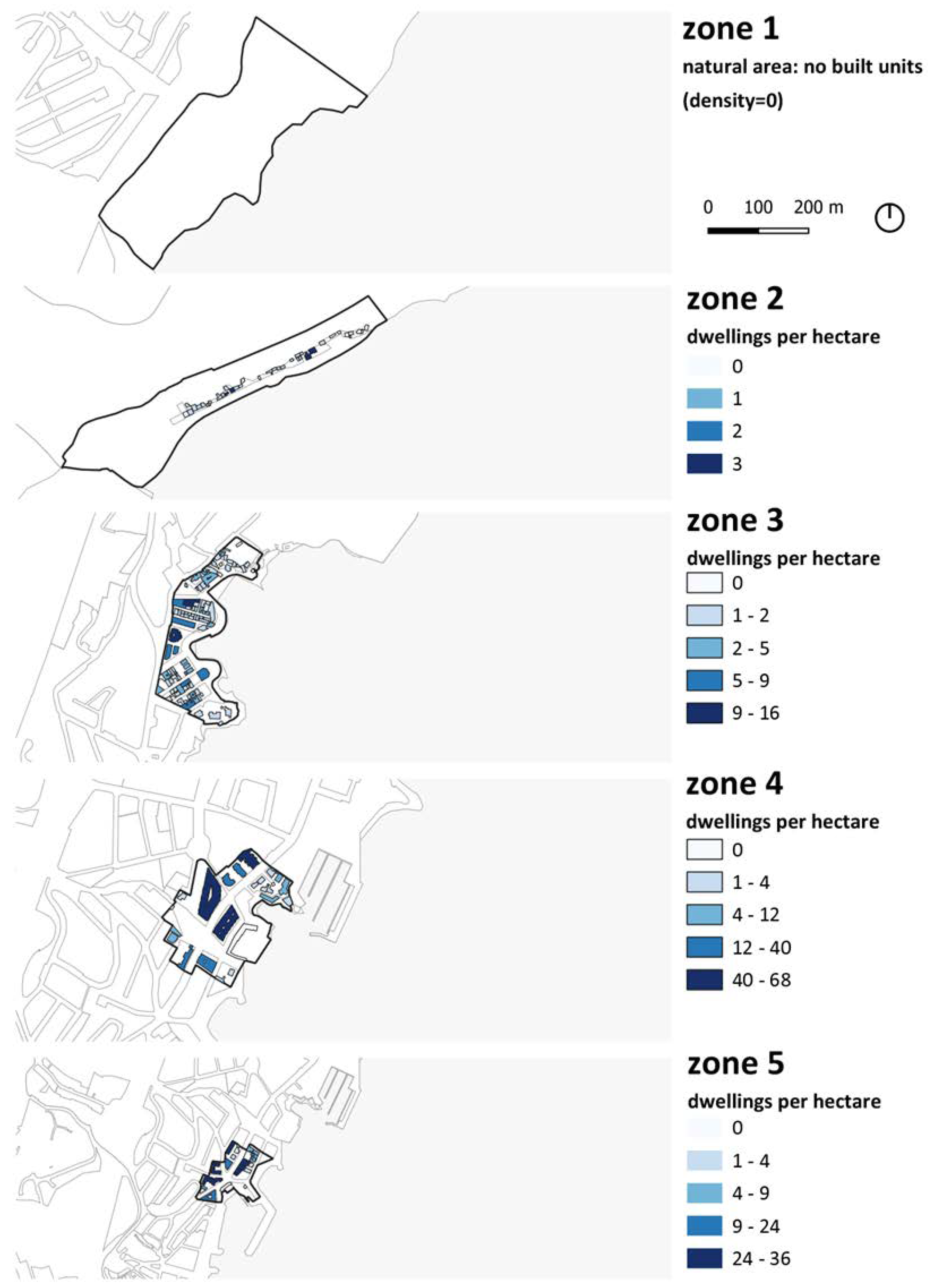
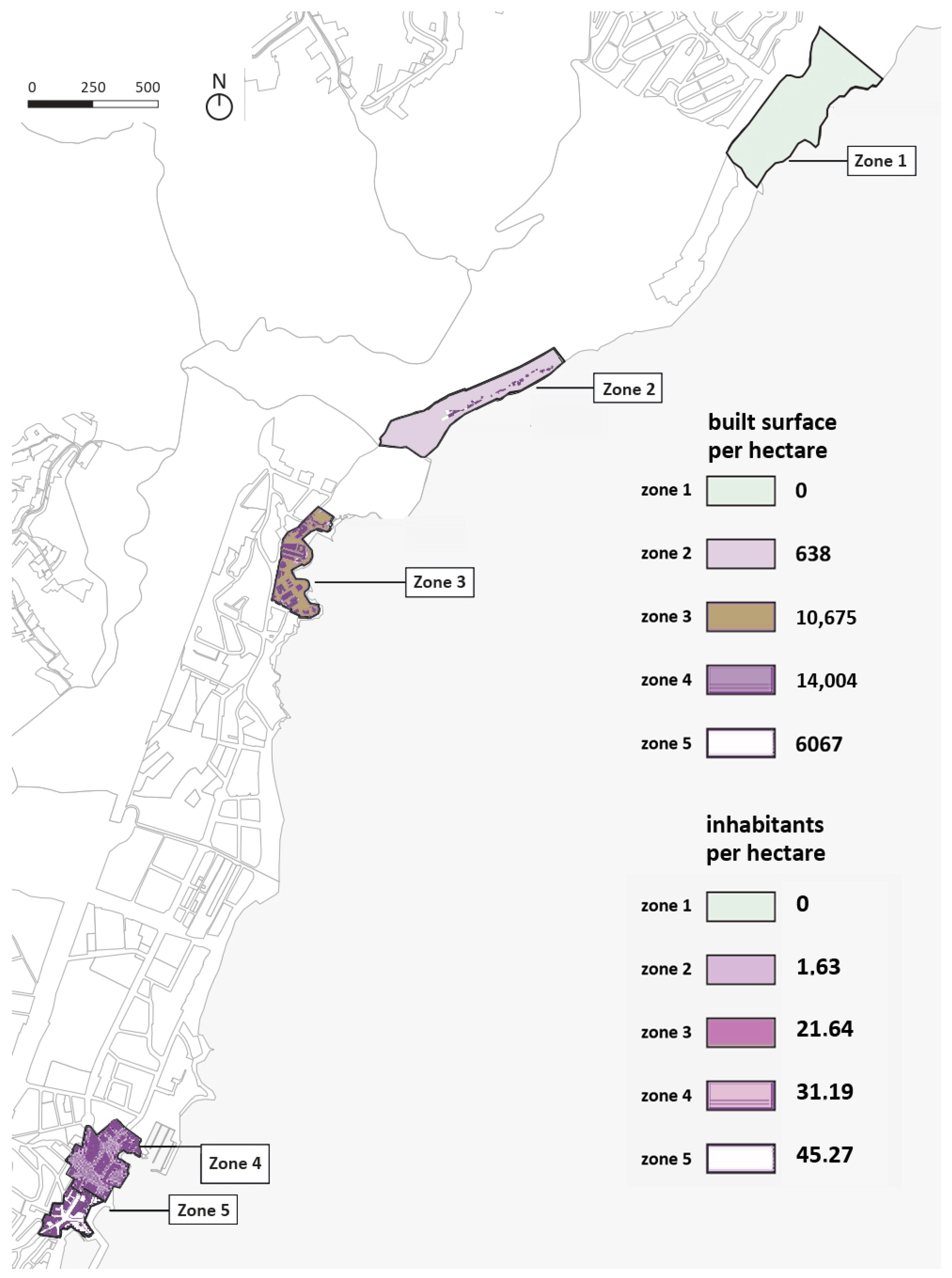
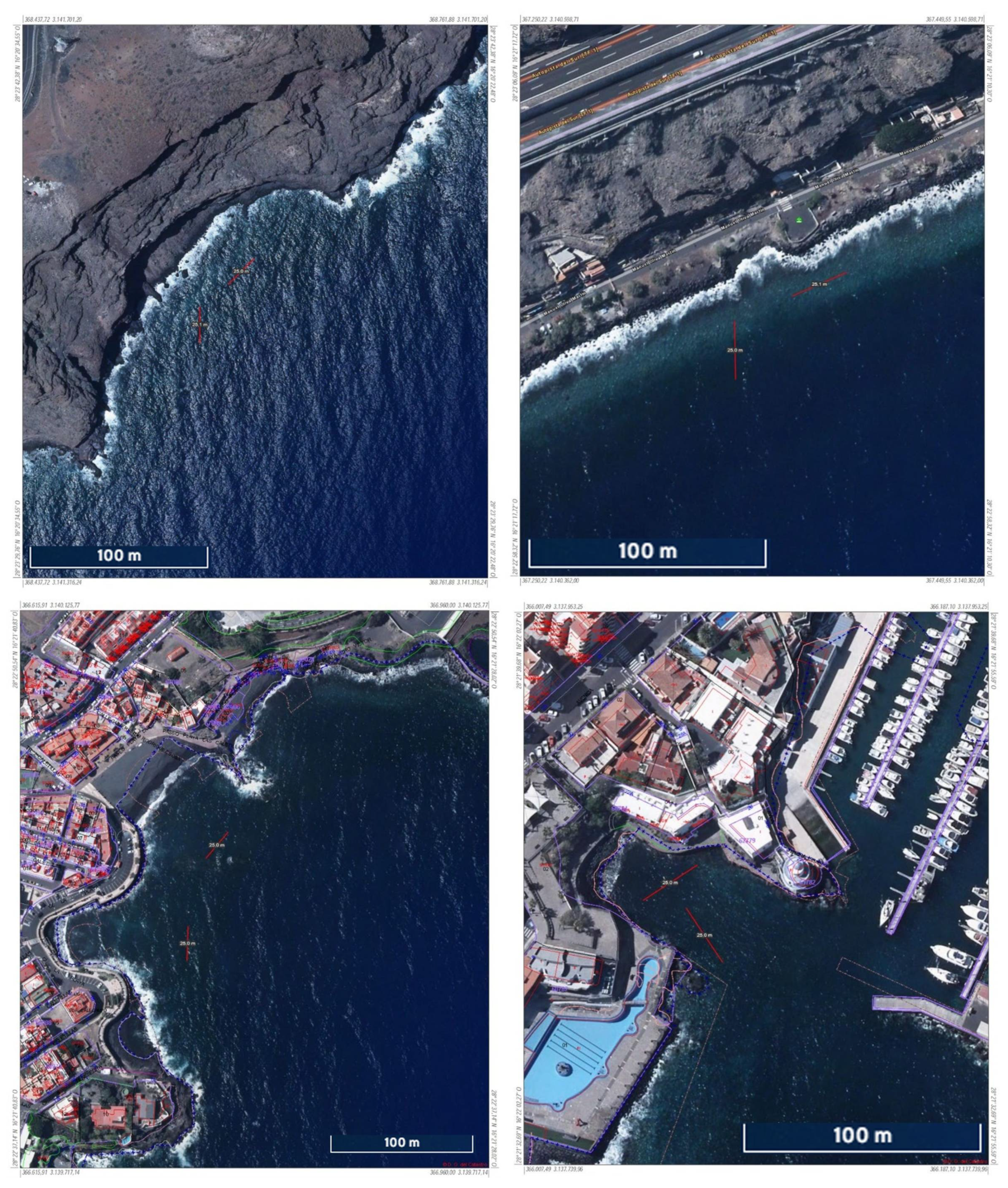

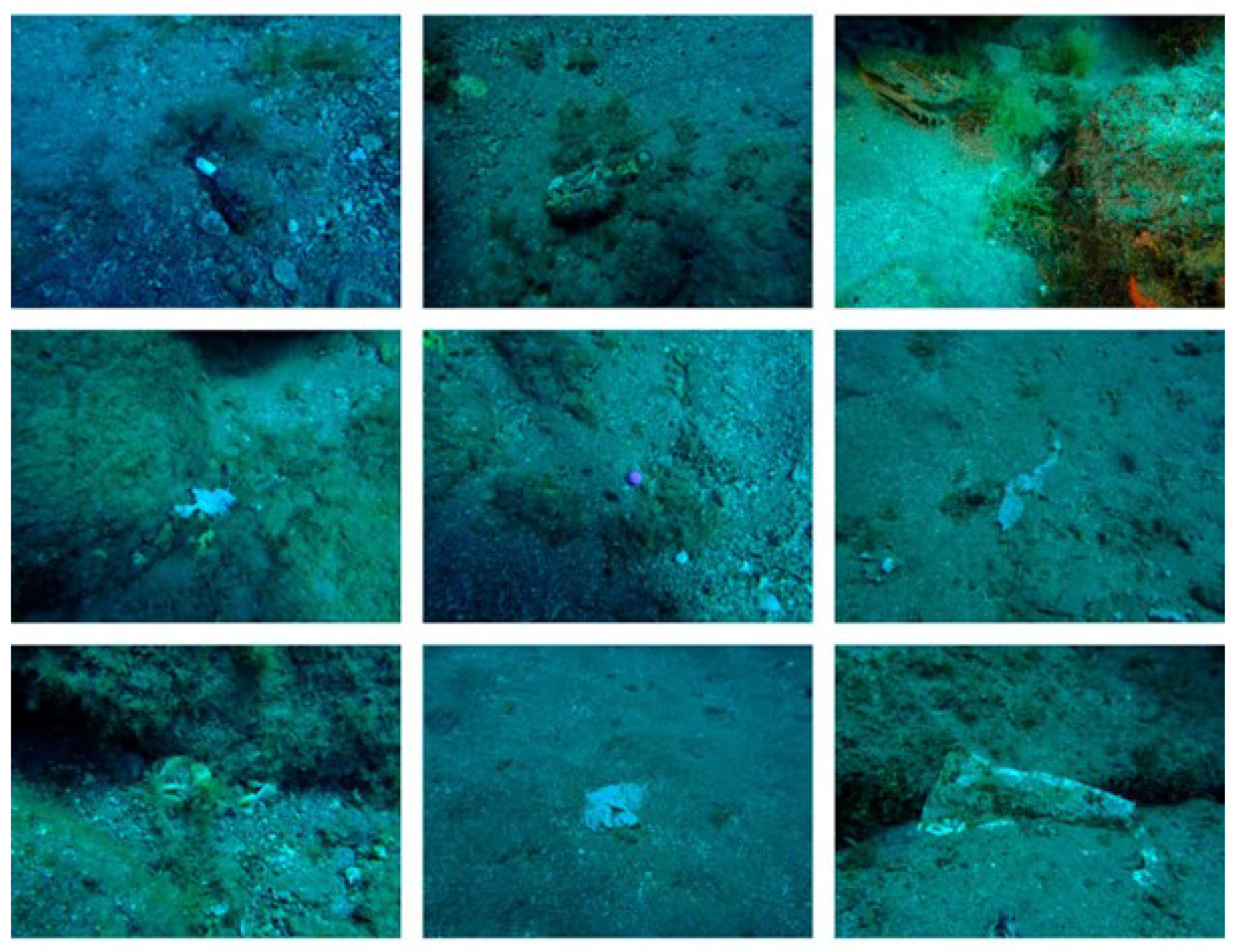
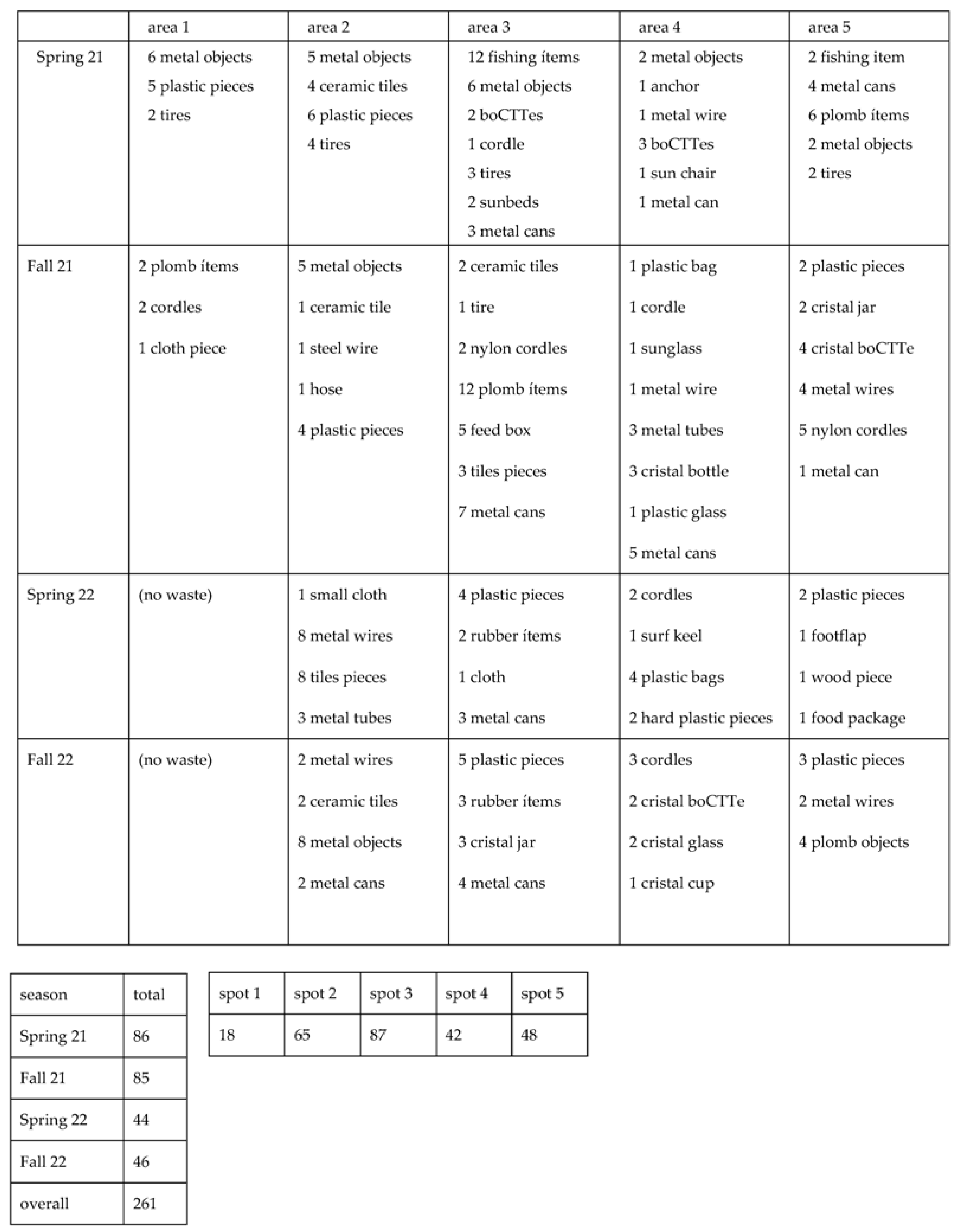
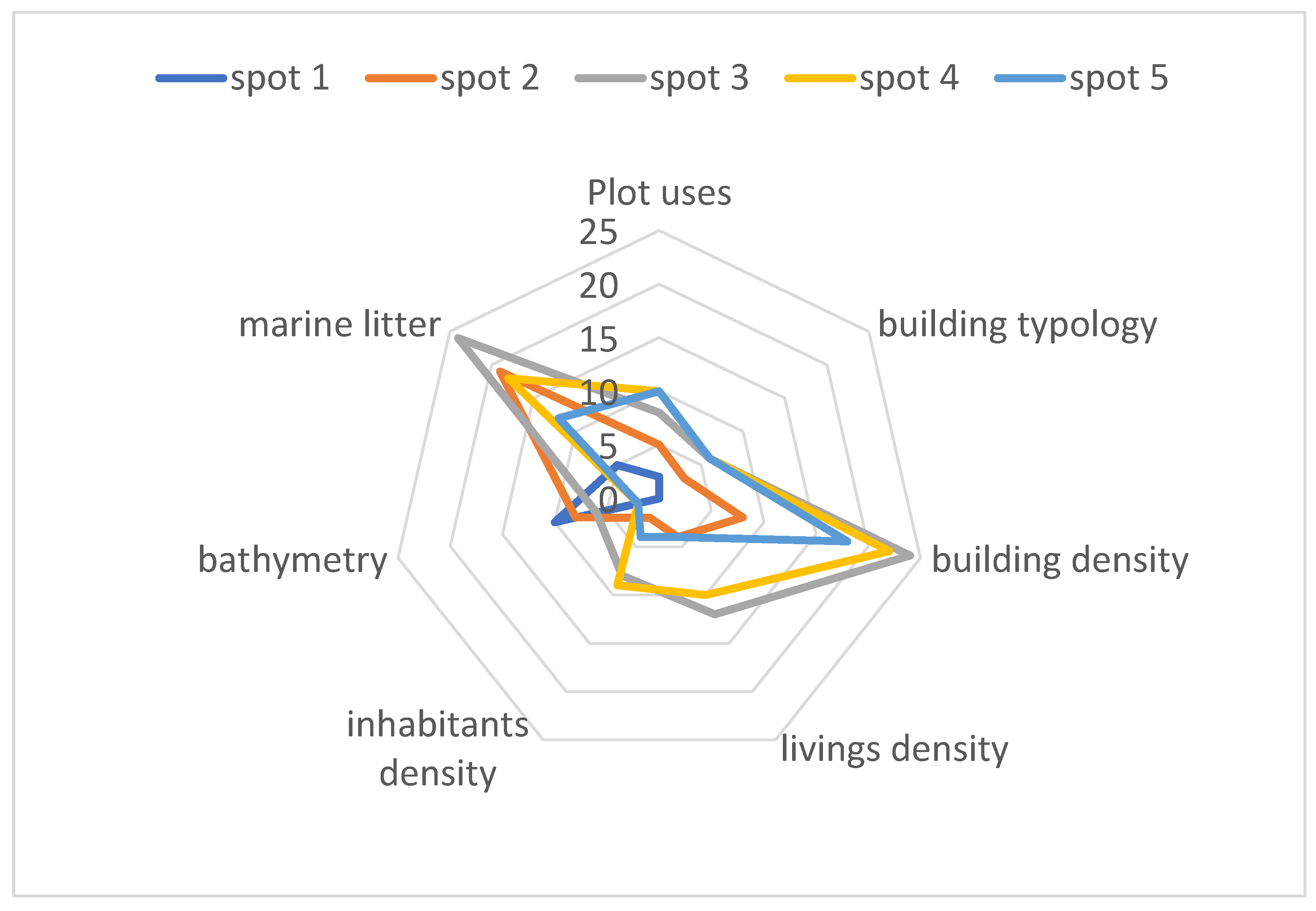
| Ind_1 Plot Uses | Ind_2 Building Typology | Ind_3 Building Density (Built sqm/Ha) | Ind_4 Livings Density (dwel/Ha) | Ind_5 Inhabitants Density (Inhab/Ha) | |
|---|---|---|---|---|---|
| zone 1 | Seaside protected non urban land | Non built | 0 | 0 | 0 |
| zone 2 | Semi-consolidated in process zone | Extense livings | 638 | 4.61 | 1.63 |
| zone 3 | Consolidated urban zone | Intense livings | 10,675 | 120.1 | 31.19 |
| zone 4 | Consolidated urban zone | Intense livings | 14,004 | 103.23 | 45.27 |
| zone 5 | Consolidated urban zone | Intense livings | 6067 | 50.9 | 21.64 |
| Medium Depth (m) | Overall Surface (Ha) | Compactness of the Substrate | Medium Slope of Bottom | |
|---|---|---|---|---|
| Spot/zone 1 | 24 | 2 | high | 38% |
| Spot/zone 2 | 12 | 3.5 | medium | 12% |
| Spot/zone 3 | 8 | 2.3 | medium | 8% |
| Spot/zone 4 | 3.5 | 1.8 | low | 5% |
| Spot/zone 5 | 3.8 | 1.2 | low | 5% |
Disclaimer/Publisher’s Note: The statements, opinions and data contained in all publications are solely those of the individual author(s) and contributor(s) and not of MDPI and/or the editor(s). MDPI and/or the editor(s) disclaim responsibility for any injury to people or property resulting from any ideas, methods, instructions or products referred to in the content. |
© 2023 by the authors. Licensee MDPI, Basel, Switzerland. This article is an open access article distributed under the terms and conditions of the Creative Commons Attribution (CC BY) license (https://creativecommons.org/licenses/by/4.0/).
Share and Cite
López-Arquillo, J.D.; Oliveira, C.; Serrano González, J.; Durán Sánchez, A. Interdependence in Coastal Tourist Territories between Marine Litter and Immediate Tourist Zoning Density: Methodological Approach for Urban Sustainable Development. Land 2024, 13, 50. https://doi.org/10.3390/land13010050
López-Arquillo JD, Oliveira C, Serrano González J, Durán Sánchez A. Interdependence in Coastal Tourist Territories between Marine Litter and Immediate Tourist Zoning Density: Methodological Approach for Urban Sustainable Development. Land. 2024; 13(1):50. https://doi.org/10.3390/land13010050
Chicago/Turabian StyleLópez-Arquillo, Juan Diego, Cristiana Oliveira, Jose Serrano González, and Amador Durán Sánchez. 2024. "Interdependence in Coastal Tourist Territories between Marine Litter and Immediate Tourist Zoning Density: Methodological Approach for Urban Sustainable Development" Land 13, no. 1: 50. https://doi.org/10.3390/land13010050
APA StyleLópez-Arquillo, J. D., Oliveira, C., Serrano González, J., & Durán Sánchez, A. (2024). Interdependence in Coastal Tourist Territories between Marine Litter and Immediate Tourist Zoning Density: Methodological Approach for Urban Sustainable Development. Land, 13(1), 50. https://doi.org/10.3390/land13010050









